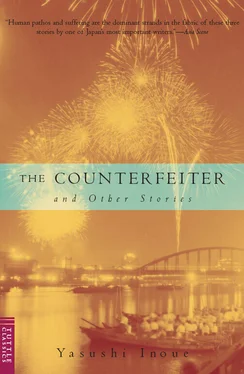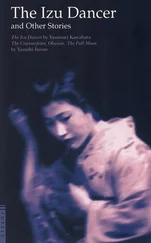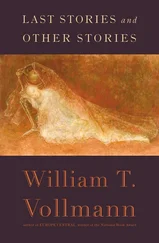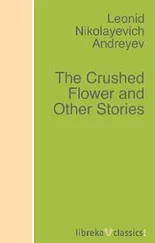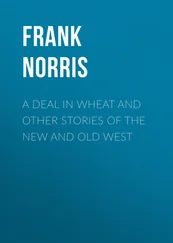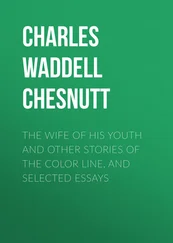Yasushi Inoue - Counterfeiter and Other Stories
Здесь есть возможность читать онлайн «Yasushi Inoue - Counterfeiter and Other Stories» весь текст электронной книги совершенно бесплатно (целиком полную версию без сокращений). В некоторых случаях можно слушать аудио, скачать через торрент в формате fb2 и присутствует краткое содержание. Год выпуска: 2000, Издательство: Tuttle Publishing, Жанр: Классическая проза, на английском языке. Описание произведения, (предисловие) а так же отзывы посетителей доступны на портале библиотеки ЛибКат.
- Название:Counterfeiter and Other Stories
- Автор:
- Издательство:Tuttle Publishing
- Жанр:
- Год:2000
- ISBN:нет данных
- Рейтинг книги:5 / 5. Голосов: 1
-
Избранное:Добавить в избранное
- Отзывы:
-
Ваша оценка:
- 100
- 1
- 2
- 3
- 4
- 5
Counterfeiter and Other Stories: краткое содержание, описание и аннотация
Предлагаем к чтению аннотацию, описание, краткое содержание или предисловие (зависит от того, что написал сам автор книги «Counterfeiter and Other Stories»). Если вы не нашли необходимую информацию о книге — напишите в комментариях, мы постараемся отыскать её.
Counterfeiter and Other Stories — читать онлайн бесплатно полную книгу (весь текст) целиком
Ниже представлен текст книги, разбитый по страницам. Система сохранения места последней прочитанной страницы, позволяет с удобством читать онлайн бесплатно книгу «Counterfeiter and Other Stories», без необходимости каждый раз заново искать на чём Вы остановились. Поставьте закладку, и сможете в любой момент перейти на страницу, на которой закончили чтение.
Интервал:
Закладка:
From then on, following upon the case of Mr. M — of Kakogawa, wherever we went, day after day, we found "Keigakus" — painted by Hosen Hara.
"This is another Hara-Keigaku, isn't it?"
"Beautifully done. Better than the original."
We continually engaged in exchanges of conversation like this, and though it was rather painful to the collectors, whenever we found forgeries, we exposed them as such. Some of them revealed themselves as forgeries at just a cursory glance, but at times there were works that were counterfeited in astoundingly exquisite and accurate detail. There were ways of identifying the forgeries because Keigaku originals had an air of artistic splendor and worth, but even beyond that, when we subjected some of the forgeries to close scrutiny, we found that they contained really gross errors here and there.
For example:
From his middle period on, Keigaku never used any whitish green in daubing his portrayals of moss and grass or rocks and crags, so forgeries which overlooked this fact or contained errors like this could be spotted at a glance. Further, a clumsiness was detectable in the forgeries when it came to the special way of using ultramarine at the bottom part of the white snow on Mount Fuji in summer, which Keigaku loved to portray. In all cases, evidence like this was available, and so the forgeries exposed themselves as forgeries.
All of the forgeries we saw had been acquired by the very same means and were by the brush of Hosen Hara. Apparently this Hara was a very ingenious man. There were instances in which the art work, the artist's signature, the seal, and everything up to the autographed case could, as a matter of course, be ascribed to Hosen himself. Among the ten or so forgeries which we saw during this trip, only two could be considered to have been done in association with a bogus country art dealer.
Hosen had been able to gain people's confidence by claiming a close personal relationship with Keigaku — and this was a trump card he always used with buyers. On top of that, there were many cases in which he would tell the buyer whether he had gotten a particular item from Keigaku or had bought it cheaply, and then proceeded to palm off a forgery. There were also cases of his saying, among other things, that he would request Keigaku to do a picture on order, and after settling on an appropriate time for delivery, he would deliver.
The fact that he used as a middleman a dishonest art dealer whose character no one knew — and there were two definite cases of this — shows that Hosen associated with crafty art dealers, and this seemed worse than his just engaging in this kind of illicit work.
On this trip we half-jokingly began to bestow upon Hosen Hara names like "Keigaku-Hara" and "Uncle Hosen." We had uncovered some ten forgeries that he had produced, and from the collectors' stories we had obtained some fragmentary bits of knowledge about Hosen, but all of these stories concerned Hosen at the age of forty or fifty. That was a period when he changed his residence from place to place, wandering about as an obscure local painter. But, beyond what could be conjectured from Takuhiko's faint recollections, there was no way of knowing to what extent he had really had a close friendship with Keigaku. When we tried to synthesize the stories of all the victims on whom Hosen had foisted forgeries, we gathered that he had lived for varying periods of time in the small cities that we had visited along the Inland Sea, but he had not settled down in any one place for as long as five years. Since he was the kind of fellow who went around selling forgeries at will, inevitably, after two or three years had passed, there would be some sort of incident so that he could not earn a living or remain in any one town and had to move on to another place. However, he always moved to other small cities that were very close by, because he would have had a hard time earning a living if he had left the places where the Keigaku enthusiasts were concentrated.
Hosen did not introduce his wife to anyone except one person, a Mr. S—, the proprietor of a saké-manufacturing company in Wake. The story goes that several times Hosen took his small but beautiful wife for visits at this person's house and that he had, to a surprising degree, commanded the trust of Mr. S—'s father.
"I think Hosen was much more an art dealer than a man who painted pictures himself. I don't remember him very well because I was just a child, but it seems to me that when my father ordered paintings from Tokyo, he ordered them through Hosen. I'd guess that most of the things in this house were acquired with his help." These were the words of the current master of the house, a forty-year-old former university rugby star who didn't have much interest in the paintings. "I think that whatever he did he did well. That's because he was an engraver. Undoubtedly we must have something in the house that Hosen engraved."
Then he searched for it, but it was nowhere to be found.
We were shown some of the works by famous Tokyo artists that the former owner had acquired with Hosen's help. They were all genuine originals, and among them there were some small but rather interesting masterpieces that are very rarely found in country places like that. Considered in this light, there apparently was another side to Hosen that brought him respectability and trust among the Tokyo artists.
"In the final analysis," Takuhiko said, "Hosen is a Keigaku specialist. But even more, he manoeuvers with discretion and doesn't palm off more than one forgery per house." Actually, he was just like that. He could be regarded as a very clever and careful man.
It would appear from our investigations that for some reason Hosen lived in Kakogawa twice. The second time was when he was past his mid-fifties. At the end of that second period of residence in Kakogawa, in 1927 or 1928, he seems to have vanished from this area.
On the fifth and final day of this trip, returning from Saidaiji, we stopped near the Himeji coast and took up lodging at a small inn whose name I don't remember. It was our intention to settle down to recover from the fatigue of the five-day journey and eat some fresh fish. As we entered the room to which we were assigned, to our surprise we discovered in the tokonoma * a landscape painting done by Hosen. It was a weird discovery. The artist's name, "Hosen," was written calligraphically in nearly square, easily legible characters, and the scroll was autographed with two seal impressions, " Kankotei " and "Hosen." Perhaps it was because we were so tired from our trip that this strange, fortuitous encounter with a work by Hosen made us feel so odd.
Takuhiko said, "We seem to be having rather close relations with Master Painter Hosen."
"This time he's revealed himself . I'd be surprised if this weren't a forgery of Hosen's work."
Both of us just stood engaging in that sort of idle chatter and staring at the scroll in the tokonoma . Actually, we had seen some ten Keigaku forgeries counterfeited by Hosen, but this was the first time for us to see his own work properly ascribed to him in his own name.
"It's not bad at all, huh?"
With an expression on his face that revealed his surprise Takuhiko said, "It could get Academy recognition."
To tell the truth, it was different, not in the least the sort of absurd art of dubious authorship that one usually finds in the tokonoma of these lodging houses. The subject, the corner of a high mountain enveloped in mist, drawn in the style of the southern painters, was quite commonplace, but it was drawn with minute precision and bore Hosen's own signature; and as we looked at it, it strangely permeated our minds.
"It has a peculiar spirit," Takuhiko said then. There certainly was something in the picture that had a peculiar spirit. For eyes that had just witnessed so many Keigaku masterpieces, this painting of course could not compete, but yet there was a spirit of destitution and solitude which had disciplined the work.
Читать дальшеИнтервал:
Закладка:
Похожие книги на «Counterfeiter and Other Stories»
Представляем Вашему вниманию похожие книги на «Counterfeiter and Other Stories» списком для выбора. Мы отобрали схожую по названию и смыслу литературу в надежде предоставить читателям больше вариантов отыскать новые, интересные, ещё непрочитанные произведения.
Обсуждение, отзывы о книге «Counterfeiter and Other Stories» и просто собственные мнения читателей. Оставьте ваши комментарии, напишите, что Вы думаете о произведении, его смысле или главных героях. Укажите что конкретно понравилось, а что нет, и почему Вы так считаете.
